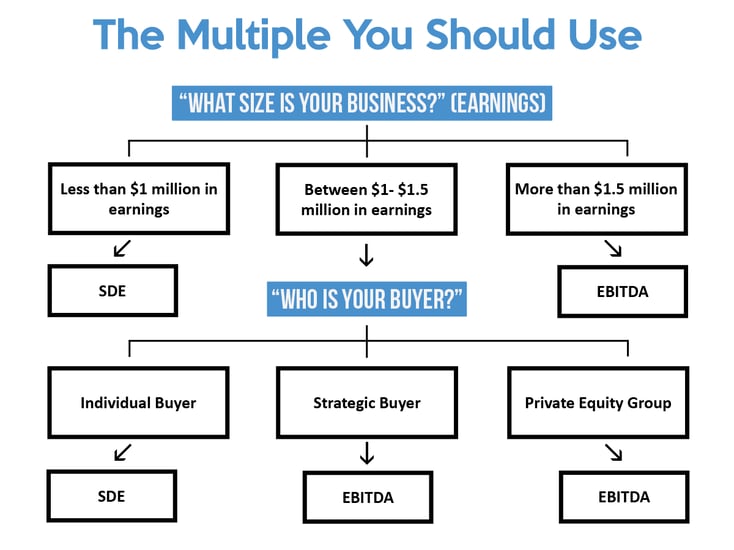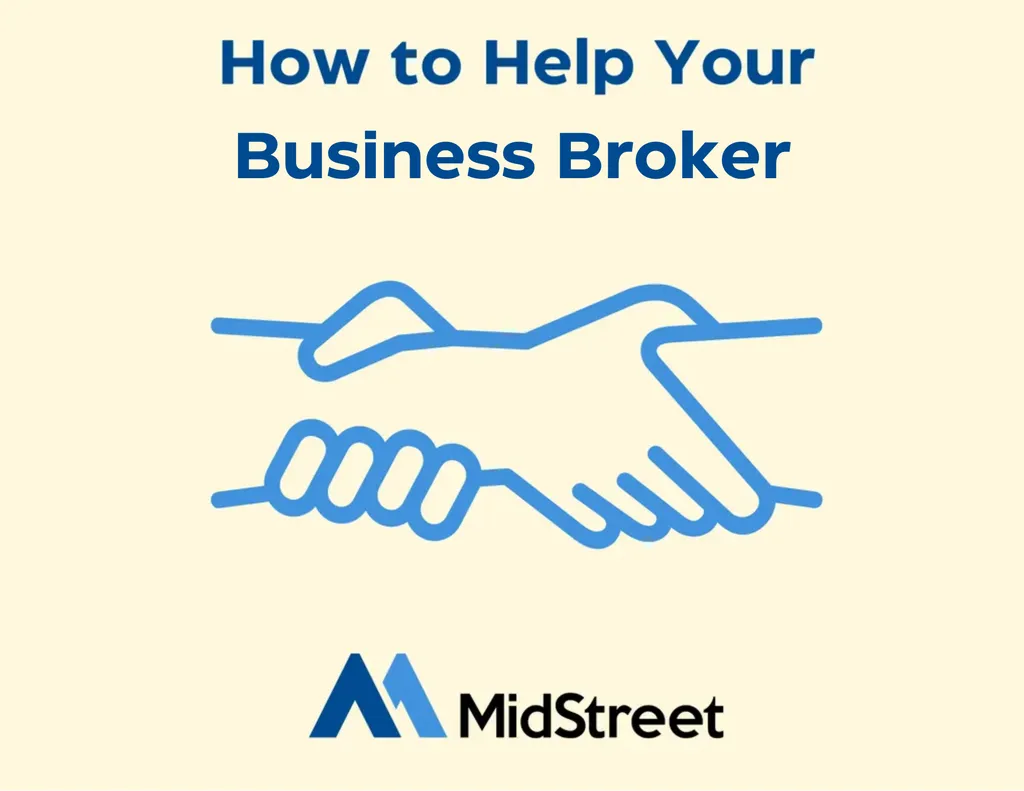What Multiple Should You Use to Value Your Business? (With Examples)
If you were asked how businesses were valued, you may guess something along the lines of “A multiple of revenue or a multiple of profit?”
While revenue and net profit are two things you heavily monitor in your daily operations, they are often the wrong choice when valuing a business - so you can’t simply apply a multiple to one of them and call it a day. Luckily, there are other measures that will give you an accurate value for your business.
At MidStreet, we have sold over 400 businesses, using careful and customized valuation methods. No two businesses are the same, which is why two businesses may have the same revenue but will almost always have two different values.
To give you a straightforward idea of how to value your business, this article will discuss the types of multiples and the factors that affect the multiple you should use. We’ll also discuss which multiples are almost always the wrong choice.
Let’s get started.
What Types of Multiples Are Used to Value Businesses?
There are a variety of multiples business analysts use when valuing a company. Some of them are correct, while others can be highly inaccurate. Here are the five most common multiples:
1. Most Common: A Multiple of SDE
A multiple of SDE refers to Seller’s Discretionary Earnings. SDE is a method used to value small to midsize businesses by taking earnings and adding back items like interest, taxes, depreciation, and other adjustments.
This method is commonly used for businesses under $1 million in earnings with an owner-operator working in the business. To learn how to calculate your business’s value using SDE, read our blog “Sellers Discretionary Earnings (SDE) Explained with Examples.”
To give you an illustration of how SDE works here is an example: you have a pest control business and its net income is $250,000, but you as the owner take a salary of $75,000. In addition, your interest, depreciation, and amortization expenses all add up to $25,000. These expenses are called "add-backs" because they get added to the net income. When we add the $250,000 net income + $75,000 for your salary, and the $25,000 calculated above, we get the the SDE of $350,000. In an industry like pest control, let’s say the average multiple is 2.7x SDE for a business of that size.
By taking the SDE of $350,000 x 2.7, you would get an estimated value of $945,000 for this company.
2. Second Most Common: A Multiple of EBITDA
The EBITDA method accounts for earnings before interest, taxes, depreciation, and amortization. The formula used to get EBITDA is:
Net Income + Interest Expense + Depreciation Expense + Amortization Expense + Taxes
It is the main method used to value business businesses with over $1 million in earnings. To help you understand EBITDA, visualize this example where you have a manufacturing business:
Your manufacturing business does $10,000,000 in revenue and has a net income of $900,000. After you add back interest, depreciation, amortization, and adjust your salary to be a market rate, the business’s EBITDA is $1,350,000.
For businesses in your industry and of comparable size, the average multiple is 4.25 x EBITDA. So the estimated value of your manufacturing company is $1,350,000 * 4.25 = $5,737,500.
3. Niche: A Multiple of Monthly Recurring Revenue
A multiple of monthly recurring revenue or MRR is a niche valuation technique and is not used as commonly as SDE or EBITDA to value businesses.
For instance, imagine you own an online recurring revenue model business with 1,000 customers paying $20 per month. With those figures, you do $20,000 per month in monthly recurring revenue (MRR).
You could use a multiple of this amount to get a valuation depending on many factors including your industry, customer demographics, profit, and growth. This method is best for niche online businesses and is not used for brick-and-mortar businesses.
4. Worst: A Multiple of Revenue
Applying a multiple to your revenue is an inaccurate valuation technique. This is one of the most common inaccurate methods business owners use to value their businesses. Using a multiple of revenue is bad because:
- Buyers are concerned with cash flow. Revenue is an important metric for strategic buyers, but it is not the most important metric for most buyers.
- Revenue multiples are hard to use because profitability varies from company to company. If the average industry profitability is 10% and your business earns 15% on average, you would not want to hold your valuation back by using a multiple of revenue.
- For some industries, like pest control, there are widely accepted margins. If a large company is looking to acquire your business, they might look at revenue because they know what the margins will be post-acquisition.
5. Even Worse: A Multiple of Net Profit
Just like you shouldn’t apply a multiple to your revenue, you should also not apply a multiple to your business’s net profit. A multiple of net profit is a bad valuation technique because:
- It is skewed by non-cash expenses like depreciation and amortization
- It takes into account your company's capital structure (ie. debt) by including interest expense
- It includes your salary, which might be very different from the market rate
- It can be skewed by your company’s accounting practices
- It is not widely used and therefore reliable comparable sales are not available
The first two methods, SDE and EBITDA, are solid valuation techniques used to value businesses every day by business brokers, merger and acquisition advisors, and buyers.
Using the last two methods, a multiple of revenue or a multiple or net profit, will often result in wildly inaccurate numbers.
Which Multiple Should You Use to Value Your Company?
Depending on a variety of factors like business size, type of buyer, industry, and level of owner involvement, you should generally use a multiple of EBITDA or SDE to value your business.

To determine whether to use a multiple of SDE or EBITDA to value your company, you should speak to an M&A advisor or consider the factors we will discuss below.
4 Factors That Affect The Multiple You Use
1. Size
The size of your company will be one of the primary factors that will affect what multiple you use:
- Companies with less than $1 million in earnings should use SDE.
- Businesses with $1 million to $1.5 million in earnings can use either SDE or EBITDA.
- Companies with more than $1.5 million in earnings should use EBITDA.
The next thing you will need to consider is the type of buyer you want to sell your business to.
2. Buyer
The type of multiple you use to value your business will differ by which type of buyer you are targeting since you should use the valuation they would most likely use:
- If you are selling to an individual buyer, you will generally use a multiple of SDE.
- If you are targeting a private equity group or a strategic buyer, you will use EBITDA.
Keep in mind, these are the types of multiples these types of buyers usually use, but they may vary slightly depending on your buyer.
3. Industry
Depending on your industry, you may naturally attract different types of buyers. For example, some PEG’s specifically seek businesses in manufacturing, technology, health care, B2B services, or logistics.
Businesses that serve other businesses or ones with recurring revenue are very appealing to private equity groups.
4. Owner Involvement
If you are not very involved in the day-to-day operations of your business, you will use a multiple of EBITDA to value your business. Buyers who look at your company as an investment will use EBITDA. Buyers who plan to be a full owner-operator of the business when they purchase it will use SDE.
Pick The Right Multiple to Value Your Business
Depending on the multiple you choose to value your business by, you may either get a highly inaccurate value of your business or one that is accurate and in agreement with market trends.
By picking the right multiple, you have a better chance of selling your business successfully and for the best price. To get a more accurate valuation of your company, you should have a business broker, M&A advisor, or valuation specialist perform a valuation for you.
We value businesses every day to provide business owners with an accurate value of their company. Are you thinking about selling your business in the near future? Call us today to find out more about getting a free valuation.




